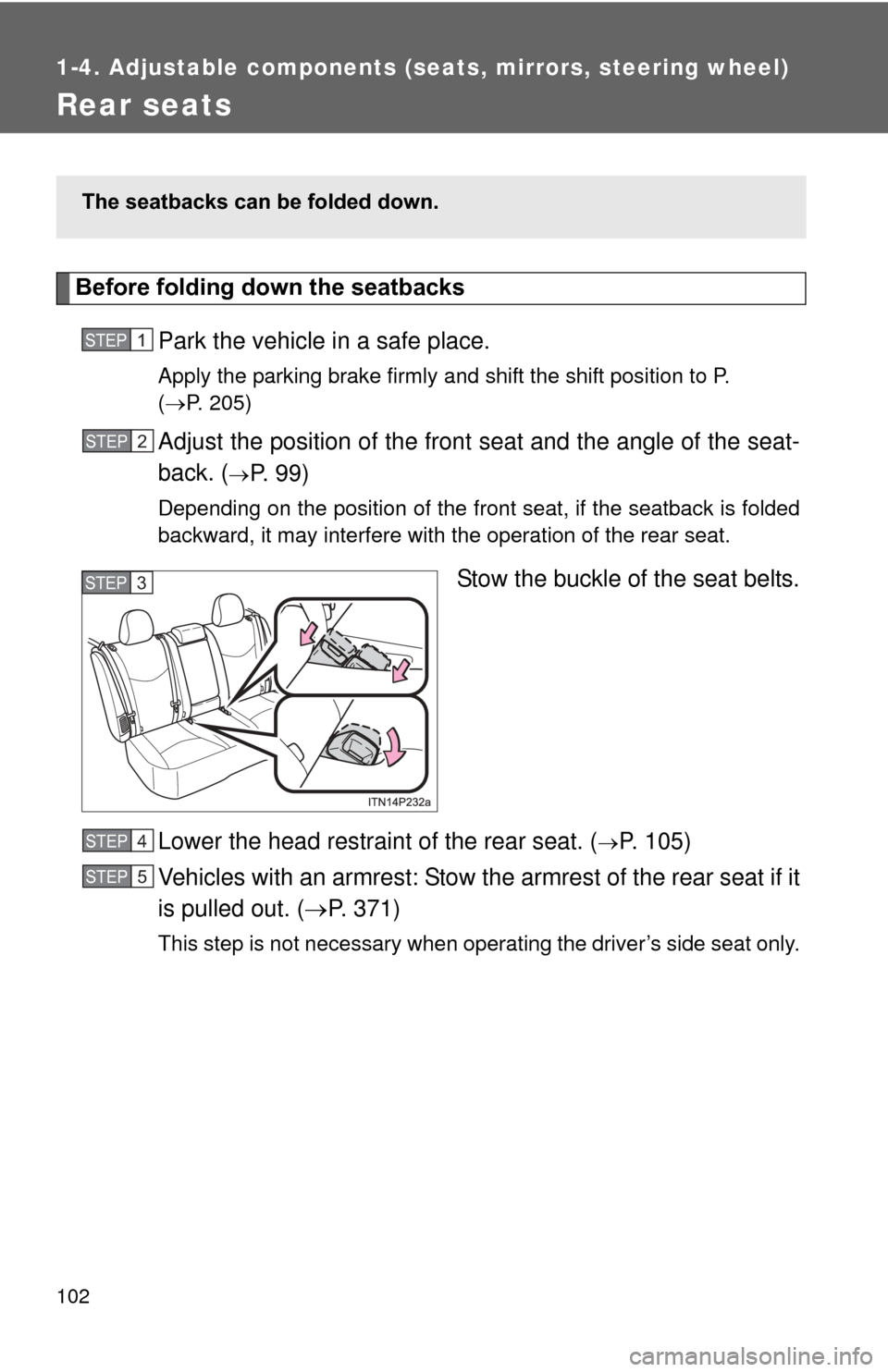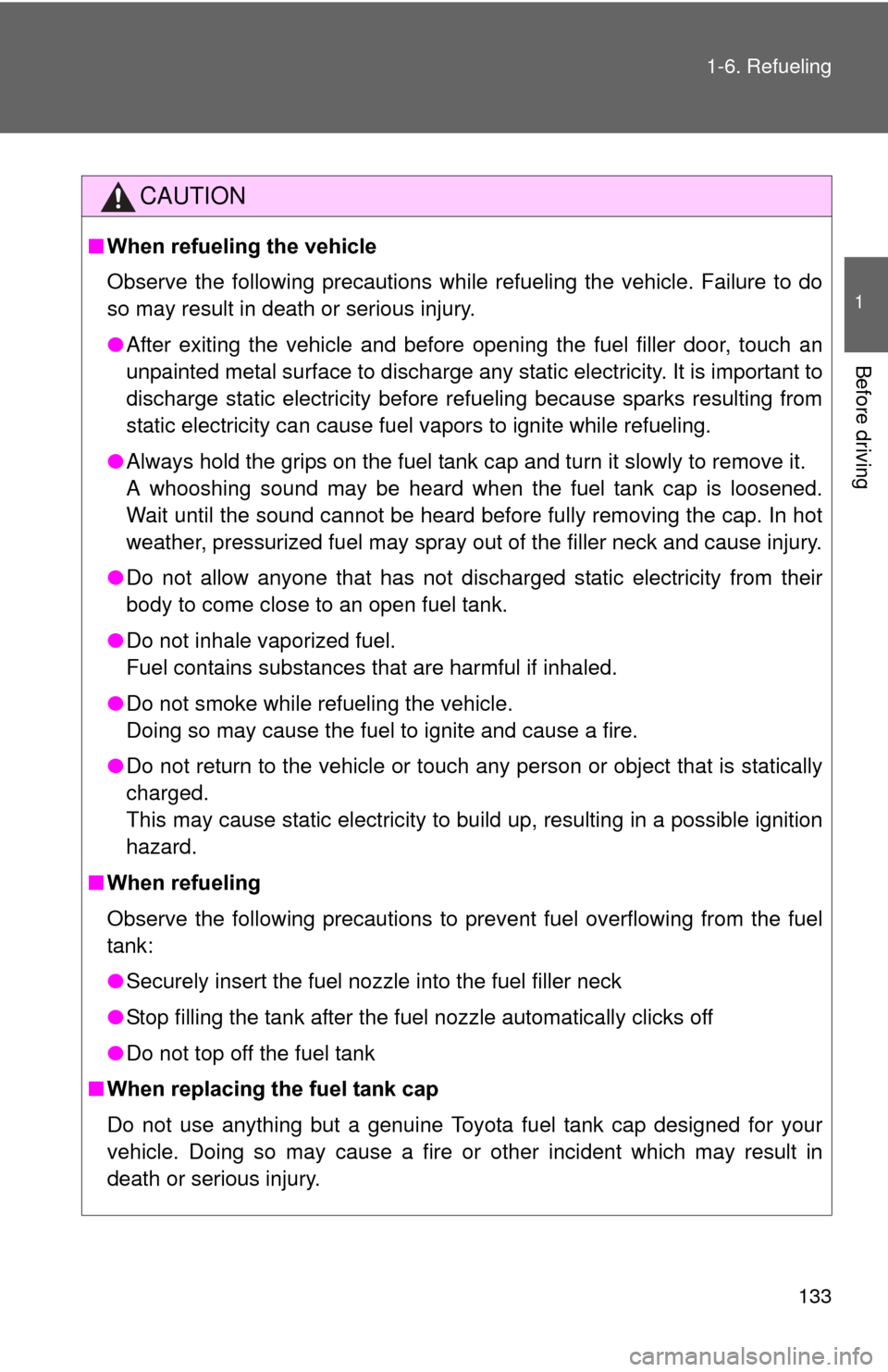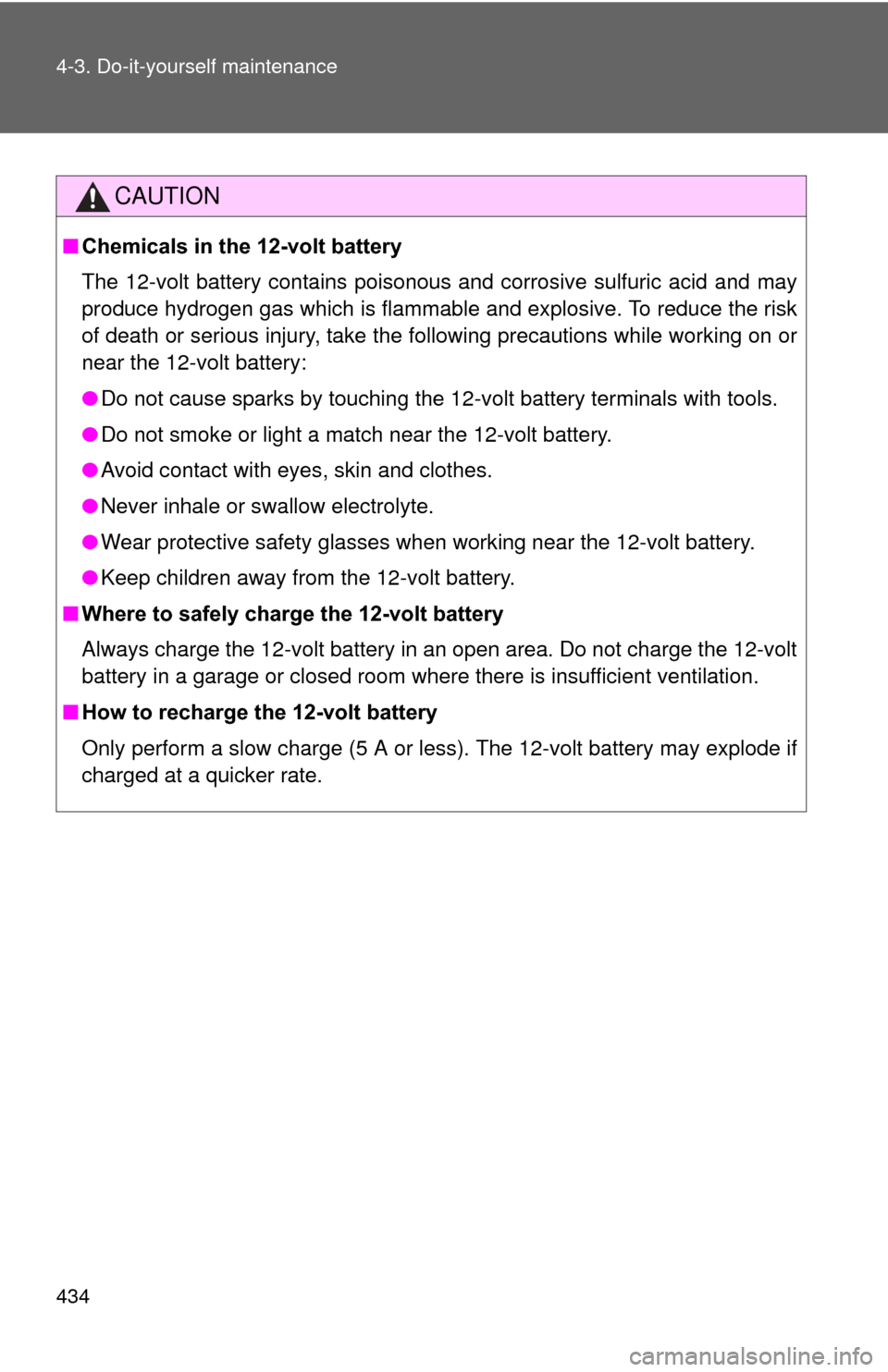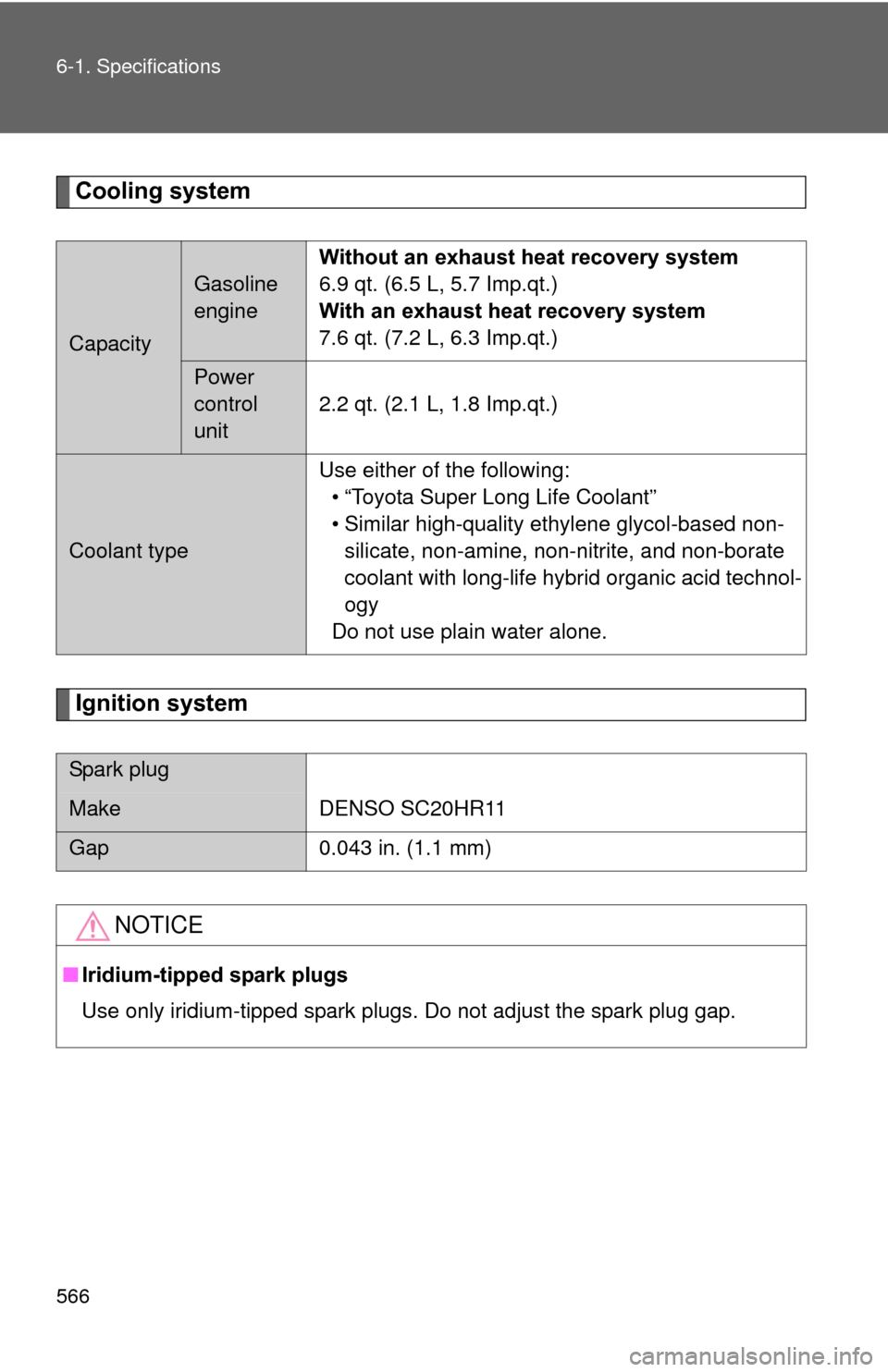2012 TOYOTA PRIUS Spark
[x] Cancel search: SparkPage 102 of 636

102
1-4. Adjustable components (seats, mirrors, steering wheel)
Rear seats
Before folding down the seatbacksPark the vehicle in a safe place.
Apply the parking brake firmly and shift the shift position to P.
(P. 205)
Adjust the position of the front seat and the angle of the seat-
back. (
P. 99)
Depending on the position of the front seat, if the seatback is folded
backward, it may interfere with the operation of the rear seat.
Stow the buckle of the seat belts.
Lower the head restraint of the rear seat. (
P. 105)
Vehicles with an armrest: Stow the armrest of the rear seat if it
is pulled out. ( P. 371)
This step is not necessary when operating the driver’s side seat only.
The seatbacks can be folded down.
STEP 1
STEP 2
STEP 3
STEP 4
STEP 5
Page 133 of 636

133
1-6. Refueling
1
Before driving
CAUTION
■
When refueling the vehicle
Observe the following precautions while refueling the vehicle. Failure to do
so may result in death or serious injury.
●After exiting the vehicle and before opening the fuel filler door, touch an
unpainted metal surface to discharge any st atic electricity. It is important to
discharge static electricity before refueling because sparks resulting from
static electricity can cause fuel vapors to ignite while refueling.
● Always hold the grips on the fuel tank cap and turn it slowly to remove it.
A whooshing sound may be heard when the fuel tank cap is loosened.
Wait until the sound cannot be heard before fully removing the cap. In hot
weather, pressurized fuel may spray out of the filler neck and cause injury.
● Do not allow anyone that has not discharged static electricity from their
body to come close to an open fuel tank.
● Do not inhale vaporized fuel.
Fuel contains substances that are harmful if inhaled.
● Do not smoke while refueling the vehicle.
Doing so may cause the fuel to ignite and cause a fire.
● Do not return to the vehicle or touch any person or object that is statically
charged.
This may cause static electricity to build up, resulting in a possible ignition
hazard.
■ When refueling
Observe the following precautions to prevent fuel overflowing from the fuel
tank:
●Securely insert the fuel nozzle into the fuel filler neck
● Stop filling the tank after the fuel nozzle automatically clicks off
● Do not top off the fuel tank
■ When replacing the fuel tank cap
Do not use anything but a genuine Toyota fuel tank cap designed for your
vehicle. Doing so may cause a fire or other incident which may result in
death or serious injury.
Page 412 of 636

412 4-3. Do-it-yourself maintenance
CAUTION
The engine compartment contains many mechanisms and fluids that may
move suddenly, become hot, or become electrically energized. To avoid death
or serious injury, observe the following precautions.
■When working on the engine compartment
●Make sure that the indicator on the “POWER” switch and the “READY”
indicator are both off.
● Keep hands, clothing and tools away from the moving fan.
● Be careful not to touch the engine, power control unit, radiator, exhaust
manifold, etc. right after driving as they may be hot. Oil and other fluids
may also be hot.
● Do not leave anything that may burn easily, such as paper and rags, in the
engine compartment.
● Do not smoke, cause sparks or expose an open flame to fuel. Fuel fumes
are flammable.
■ When working near the electric c ooling fans or radiator grille
Be sure the “POWER” switch is off.
With the “POWER” switch in ON mode, the electric cooling fans may auto-
matically start to run if the air conditioning is on and/or the coolant tempera-
ture is high. ( P. 426)
■ Safety glasses
Wear safety glasses to prevent flying or falling material, fluid spray, etc. from
getting in your eyes.
NOTICE
■If you remove the air cleaner filter
Driving with the air cleaner filter removed may cause excessive engine wear
due to dirt in the air. Also, a backfire could cause a fire in the engine com-
partment.
Page 434 of 636

434 4-3. Do-it-yourself maintenance
CAUTION
■Chemicals in the 12-volt battery
The 12-volt battery contains poisonous and corrosive sulfuric acid and may
produce hydrogen gas which is flammable and explosive. To reduce the risk
of death or serious injury, take the following precautions while working on or
near the 12-volt battery:
●Do not cause sparks by touching the 12-volt battery terminals with tools.
● Do not smoke or light a match near the 12-volt battery.
● Avoid contact with eyes, skin and clothes.
● Never inhale or swallow electrolyte.
● Wear protective safety glasses when working near the 12-volt battery.
● Keep children away from the 12-volt battery.
■ Where to safely charge the 12-volt battery
Always charge the 12-volt battery in an open area. Do not charge the 12-volt
battery in a garage or closed room where there is insufficient ventilation.
■ How to recharge the 12-volt battery
Only perform a slow charge (5 A or less). The 12-volt battery may explode if
charged at a quicker rate.
Page 566 of 636

566 6-1. Specifications
Cooling system
Ignition system
Capacity
Gasoline
engine
Without an exhaust heat recovery system
6.9 qt. (6.5 L, 5.7 Imp.qt.)
With an exhaust heat recovery system
7.6 qt. (7.2 L, 6.3 Imp.qt.)
Power
control
unit2.2 qt. (2.1 L, 1.8 Imp.qt.)
Coolant type Use either of the following:
• “Toyota Super Long Life Coolant”
• Similar high-quality ethylene glycol-based non- silicate, non-amine, non-nitrite, and non-borate
coolant with long-life hybrid organic acid technol-
ogy
Do not use plain water alone.
Spark plug
Make DENSO SC20HR11
Gap 0.043 in. (1.1 mm)
NOTICE
■Iridium-tipped spark plugs
Use only iridium-tipped spark plugs. Do not adjust the spark plug gap.
Page 625 of 636

625
Alphabetical index
Replacing
Electronic key battery ........... 454
Fuses.................................... 456
Light bulbs ............................ 467
Tires ..................................... 523
Reporting safety defects for U.S. owners ........................... 600
Safety Connect ........................ 388
Seat belt reminder light .......... 498
Seat belts Adjusting the seat belt .......... 110
Automatic Locking Retractor (ALR).................................. 111
Child restraint system installation .......................... 165
Cleaning and maintaining the seat belt ....................... 400
Emergency Locking Retractor
(ELR) ................................. 111
How to wear your seat belt ............................. 109
How your child should wear the seat belt ....................... 111
Pre-collision seat belts ......... 303
Pregnant women,
proper seat belt use ........... 113
Reminder light ...................... 498
Seat belt extenders .............. 112
Seat belt instructions for Canadian owners .......... 601
Seat belt pretensioners ........ 110
Seat heaters ............................. 369
Seating capacity ...................... 316 Seats
Adjustment .....................99, 102
Adjustment
precautions .................101, 104
Child seats/child restraint
system installation ..............165
Cleaning ................................399
Folding down the seatbacks............................103
Head restraint........................105
Properly sitting in the seat .....138
Seat heaters ..........................369
Service reminder indicators ..............................219
Shift lever Transmission .........................202
Side airbags..............................140
Side marker lights
Replacing light bulbs .............467
Switch....................................250
Wattage .................................570
Side mirrors Adjusting and folding ............. 121
Smart key system Antenna location .....................64
Entry functions ........................61
Starting the hybr id system.....192
Solar Ventilation System .........339
SOS button ...............................388
Spare tire Inflation pressure...................569
Storage location ....................523
Spark plug ................................566
Specifications...........................560
Speedometer ............................214
S
*: Refer to “Display Audio System Owner’s Manual” or “Navigation System Owner’s Manual”.